Heavy Rainfall Induced by Typhoon Yagi-2024 at Hainan and Vietnam, and Dynamical Process
Abstract
1. Introduction
2. Materials and Methods
2.1. Data
2.2. Methods
2.2.1. Ekman Layer’s Horizontal Transport
2.2.2. Moisture Flux and Its Convergence
- Typhoon Yagi:
3. Results
3.1. SST and Wind Variations During Typhoon Yagi
3.2. SST Variation over the Selected Areas
3.3. Rainfall Variations During Typhoon Yagi
3.4. Rainfall Variations over the Selected Areas
3.5. Enthalpy Flux Variations
3.6. MF and MFC Variations
4. Discussion
4.1. SST Cooling Due to Typhoon Yagi
4.2. Dynamical Process for Heavy Rainfall over Vietnam
5. Conclusions
Supplementary Materials
Author Contributions
Funding
Institutional Review Board Statement
Informed Consent Statement
Data Availability Statement
Acknowledgments
Conflicts of Interest
References
- Ahrens, C.D.; Henson, R. Meteorology Today: An Introduction to Weather, Climate, and the Environment; Cengage Learning: Toronto, ON, Canada, 2015; pp. 439–446. [Google Scholar]
- Hun, K.S.; Ju, M.I.; Shin, C.P. An increase in global trends of tropical cyclone translation speed since 1982 and its physical causes. Environ. Res. Lett. 2020, 15, 094084. [Google Scholar] [CrossRef]
- Guan, S.; Zhao, W.; Sun, L.; Zhou, C.; Liu, Z.; Hong, X.; Zhang, Y.; Tian, J.; Hou, Y. Tropical cyclone-induced sea surface cooling over the Yellow Sea and Bohai Sea in the 2019 Pacific typhoon season. J. Mar. Syst. 2021, 217, 103509. [Google Scholar] [CrossRef]
- Shay, L.K.; Goni, G.J.; Black, P.G. Role of a warm ocean feature on Hurricane Opal. Mon. Weather Rev. 2000, 128, 1366–1383. [Google Scholar] [CrossRef]
- Wu, C.-C.; Lee, C.-Y.; Lin, I.-I. The effect of the ocean eddy on tropical cyclone intensity. J. Atmos. Sci. 2007, 64, 3562–3578. [Google Scholar] [CrossRef]
- Lin, I.I.; Wu, C.C.; Pun, I.F.; Ko, D.S. Upper-ocean thermal structure and the western North Pacific category-5 typhoons. Part I: Ocean features and category-5 typhoon’s intensification. Mon. Weather Rev. 2008, 136, 3288–3306. [Google Scholar] [CrossRef]
- Lin, I.-I.; Pun, I.-F.; Wu, C.-C. Upper-ocean thermal structure and the western North Pacific category 5 typhoons. Part II: Dependence on translation speed. Mon. Weather. Rev. 2009, 137, 3744–3757. [Google Scholar] [CrossRef]
- Vincent, E.M.; Emanuel, K.A.; Lengaigne, M.; Vialard, J.; Madec, G. Influence of upper ocean stratification interannual variability on tropical cyclone. J. Adv. Model. Earth Syst. 2014, 6, 680–699. [Google Scholar] [CrossRef]
- Mei, W.; Lien, C.-C.; Lin, I.-I.; Xie, S.-P. Tropical cyclone–induced ocean response: A comparative study of the south China sea and Tropical Northwest Pacific. J. Clim. 2015, 28, 5952–5968. [Google Scholar] [CrossRef]
- Price, J.F.; Morzel, J.; Niiler, P.P. Warming of SST in the cool wake of a moving hurricane. J. Geophys. Res. Oceans 2008, 113, C07010. [Google Scholar] [CrossRef]
- Fisher, E.L. Hurricanes and the sea-surface temperature field. J. Atmos. Sci. 1958, 15, 328–333. [Google Scholar] [CrossRef]
- Leipper, D. Observed ocean conditions and Hurricane Hilda, 1964. J. Atmos. Sci. 1967, 24, 182–196. [Google Scholar] [CrossRef]
- Price, J.F. Upper ocean response to a hurricane. J. Phys. Oceanogr. 1981, 11, 153–175. [Google Scholar] [CrossRef]
- Greatbatch, R.J. On the role played by upwelling of water in lowering sea surface temperatures during the passage of a storm. J. Geophys. Res. Oceans 1985, 90, 11751–11755. [Google Scholar] [CrossRef]
- Stramma, L.; Cornillon, P.; Weller, R.A.; Price, J.F.; Briscoe, M.G. Large diurnal sea surface temperature variability: Satellite and in situ measurements. J. Phys. Oceanogr. 1986, 16, 827–837. [Google Scholar] [CrossRef]
- Shay, L.K.; Black, P.G.; Mariano, A.J.; Hawkins, J.D.; Elsberry, R.L. Upper ocean response to Hurricane Gilbert. J. Geophys. Res. Oceans 1992, 97, 20227–20248. [Google Scholar] [CrossRef]
- Suetsugu, M.; Kawamura, H.; Nishihama, S. Sea surface cooling caused by typhoons in the western North Pacific Ocean. PORSEC Proc. Goa 2000, 1, 258–262. [Google Scholar]
- Bender, M.A.; Ginis, I. Real-case simulations of hurricane-ocean interaction using a high-resolution coupled model: Effects on hurricane intensity. Mon. Weather Rev. 2000, 128, 917–946. [Google Scholar] [CrossRef]
- Sadhuram, Y. Record decrease of sea surface temperature following the passage of a super cyclone over the Bay of Bengal. Curr. Sci. 2004, 86, 383–384. [Google Scholar]
- Ren, X.; Perrie, W.; Long, Z.; Gyakum, J. Atmosphere-ocean coupled dynamics of cyclones in the midlatitudes. Mon. Weather Rev. 2004, 132, 2432–2451. [Google Scholar] [CrossRef]
- Miller, B.I. On the maximum intensity of hurricanes. J. Meteorol. 1958, 15, 184–195. [Google Scholar] [CrossRef]
- Malkus, J.S.; Riehl, H. On the dynamics and energy transformation in steady-state hurricanes. Tellus 1960, 12, 1–20. [Google Scholar] [CrossRef]
- Sutyrin, G.G.; Khain, A.P. Effect of the ocean-atmosphere interaction on the intensity of a moving tropical cyclone. Atmos. Ocean Phys. 1984, 20, 787–794. [Google Scholar]
- Khain, A.P.; Ginis, I.D. The mutual response of a moving tropical cyclone and the ocean. Beitr. Phys. Atmos. 1991, 64, 125–142. [Google Scholar]
- Falkovich, A.I.; Khain, A.P.; Ginis, I. The influence of air-sea interaction on the development and motion of a tropical cyclone: Numerical experiments with a triply nested model. Meteorol. Atmos. Phys. 1995, 55, 167–184. [Google Scholar] [CrossRef]
- Cione, J.J.; Uhlhorn, E.W. Sea surface temperature variability in hurricanes: Implications with respect to intensity change. Mon. Weather. Rev. 2003, 131, 1783–1796. [Google Scholar] [CrossRef]
- Chan, J.C.L.; Duan, Y.; Shay, L.K. Tropical cyclone intensity change from a simple ocean–atmosphere coupled model. J. Atmos. Sci. 2001, 58, 154–172. [Google Scholar] [CrossRef]
- Deng, Z.; Villarini, G.; Wang, Z. Climate change dominates over urbanization in tropical cyclone rainfall patterns. Commun. Earth Environ. 2025, 6, 54. [Google Scholar] [CrossRef]
- Feng, Z.; Liao, C.; Zeng, J. Comparative analysis of heavy rainfall area between landfalling typhoon lupit (2109) and Typhoon lisa (9610). Trop. Cyclone Res. Rev. 2024, 13, 175–186. [Google Scholar] [CrossRef]
- Gao, S.; Zhai, S.; Li, T.; Chen, Z. On the asymmetric distribution of shear-relative typhoon rainfall. Meteorol. Atmos. Phys. 2018, 130, 11–22. [Google Scholar] [CrossRef]
- Yang, M.-J.; Braun, S.A.; Chen, D.-S. Water budget of Typhoon Nari (2001). Mon. Weather Rev. 2010, 139, 3809–3828. [Google Scholar] [CrossRef]
- Suthinkumar, P.; Varikoden, H.; Babu, C. Changes in extreme rainfall events in the recent decades and their linkage with atmospheric moisture transport. Glob. Planet. Change 2023, 221, 104047. [Google Scholar] [CrossRef]
- Feng, X.; Shu, S. How do weak tropical cyclones produce heavy rainfall when making landfall over China. J. Geophys. Res. Atmos. 2018, 123, 11830–11848. [Google Scholar] [CrossRef]
- Jiang, H.; Halverson, J.B.; Zipser, E.J. Influence of environmental moisture on TRMM-derived tropical cyclone precipitation over land and ocean. Geophys. Res. Lett. 2008, 35, L17806. [Google Scholar] [CrossRef]
- Li, W.-P. Moisture flux and water balance over the South China Sea during Late Boreal spring and summer. Theor. Appl. Clim. 1999, 64, 179–187. [Google Scholar] [CrossRef]
- Sun, B.; Wang, H.; Zhou, B. Interdecadal Variation of the Relationship between East Asian Water Vapor Transport and Tropical Pacific Sea Surface Temperatures during January and Associated Mechanisms. J. Clim. 2019, 32, 7575–7594. [Google Scholar] [CrossRef]
- Kim, J.; Ho, C.; Lee, M.; Jeong, J.; Chen, D. Large Increase in Heavy Rainfall Associated with Tropical Cyclone Landfalls in Korea After the Late 1970s. Geophys. Res. Lett. 2006, 33, L18706. [Google Scholar] [CrossRef]
- Lau, K.; Wu, H. Have Tropical Cyclones Been Feeding More Extreme Rainfall? J. Geophys. Res. Atmos. 2008, 113, D23113. [Google Scholar] [CrossRef]
- Lau, W.K.M.; Zhou, Y.P. Observed Recent Trends in Tropical Cyclone Rainfall over the North Atlantic and the North Pacific. J. Geophys. Res. Atmos. 2012, 117, D03104. [Google Scholar] [CrossRef]
- Knutson, T.R.; McBride, J.L.; Chan, J.; Emanuel, K.; Holland, G.; Landsea, C.; Held, I.; Kossin, J.P.; Srivastava, A.K.; Sugi, M. Tropical Cyclones and Climate Change. Nat. Geosci. 2010, 3, 157–163. [Google Scholar] [CrossRef]
- Hsu, H.-H.; Chou, C.; Wu, Y.C.; Lu, M.M.; Chen, T.; Chen, Y.M. Science Report of Climate Change in Taiwan 2011; National Science Council: Taipei, Taiwan, 2011; 362p. (In Chinese) [Google Scholar]
- Chang, C.; Lei, Y.; Sui, C.; Lin, X.; Ren, F. Tropical Cyclone and Extreme Rainfall Trends in East Asian Summer Monsoon Since Mid-20th Century. Geophys. Res. Lett. 2012, 39, L18702. [Google Scholar] [CrossRef]
- Shapiro, L.J. Asymmetric Boundary Layer Flow Under a Translating Hurricane. J. Atmos. Sci. 1983, 40, 1984–1998. [Google Scholar] [CrossRef]
- Bender, M.A. The Effect of Relative Flow on the Asymmetric Structure in the Interior of Hurricanes. J. Atmos. Sci. 1997, 54, 703–724. [Google Scholar] [CrossRef]
- Frank, W.M.; Ritchie, E.A. Effects of Environmental Flow upon Tropical Cyclone Structure. Mon. Weather. Rev. 1999, 127, 2044–2061. [Google Scholar] [CrossRef]
- Lonfat, M.; Marks, F.D., Jr.; Chen, S.S. Precipitation Distribution in Tropical Cyclones Using the Tropical Rainfall Measuring Mission (TRMM) Microwave Imager: A Global Perspective. Mon. Weather. Rev. 2004, 132, 1645–1660. [Google Scholar] [CrossRef]
- Lin, Y.Y.; Liu, Y.Q.; Zhang, L.Q. An Analysis on the Impact of Severe Tropical Storm “Maria” on the Torrential Heavy Rain in Shaoguan. Guangdong Meteorol. 2001, 3, 5–7. [Google Scholar]
- Li, J.N.; Wang, A.Y.; Yang, Z.L.; Li, G.L.; He, X.J.; Peng, T.Y.; Gu, Z.M. Advancement in the Study of Typhoon Rainstorm. J. Trop. Meteorol. 2003, 19, 152–159. (In Chinese) [Google Scholar]
- Jacob, S.D.; Koblinsky, C.J. Effects of Precipitation on the Upper-Ocean Response to a Hurricane. Mon. Weather Rev. 2007, 135, 2207–2225. [Google Scholar] [CrossRef]
- Yokoyama, C.; Takayabu, Y.N. A Statistical Study on Rain Characteristics of Tropical Cyclones Using TRMM Satellite Data. Mon. Weather Rev. 2008, 136, 3848–3862. [Google Scholar] [CrossRef]
- Chen, S.S.; Knaff, J.A.; Marks, F.D., Jr. Effects of Vertical Wind Shear and Storm Motion on Tropical Cyclone Rainfall Asymmetries Deduced from TRMM. Mon. Weather. Rev. 2006, 134, 3190–3208. [Google Scholar] [CrossRef]
- Subrahmanyam, M.V. Impact of Typhoon on the North-West Pacific Sea Surface Temperature: A Case Study of Typhoon Kaemi (2006). Nat. Hazards 2015, 78, 569–582. [Google Scholar] [CrossRef]
- Chu, J.H.; Sampson, C.R.; Levine, A.S.; Fukada, E. The Joint Typhoon Warning Center Tropical Cyclone Best-Tracks, 1945–2000. Rep. NRL/MR/7540-02-16, Joint Typhoon Warning Center, Hawaii. 2002. Available online: https://www.usno.navy.mil/NOOC/nmfc-ph/RSS/jtwc/best_tracks/TC_bt_report.html (accessed on 22 April 2025).
- Kilpatrick, K.A.; Podestá, G.P.; Evans, R. Overview of the NOAA/NASA Advanced Very High Resolution Radiometer Pathfinder algorithm for sea surface temperature and associated matchup database. J. Geophys. Res. Space Phys. 2001, 106, 9179–9197. [Google Scholar] [CrossRef]
- Huang, B.; Liu, C.; Banzon, V.; Freeman, E.; Graham, G.; Hankins, B.; Smith, T.; Zhang, H.-M. Improvements of the Daily Optimum Interpolation Sea Surface Temperature (DOISST) Version 2.1. J. Clim. 2021, 34, 2923–2939. [Google Scholar] [CrossRef]
- Banzon, V.; Smith, T.M.; Chin, T.M.; Liu, C.; Hankins, W. A long-term record of blended satellite and in situ sea-surface temperature for climate monitoring, modeling and environmental studies. Earth Syst. Sci. Data 2016, 8, 165–176. [Google Scholar] [CrossRef]
- Reynolds, R.W.; Smith, T.M.; Liu, C.; Chelton, D.B.; Casey, K.S.; Schlax, M.G. Daily high-resolution-blended analyses for sea surface temperature. J. Clim. 2007, 20, 5473–5496. [Google Scholar] [CrossRef]
- Hersbach, H.; Bell, B.; Berrisford, P.; Hirahara, S.; Horányi, A.; Muñoz-Sabater, J.; Nicolas, J.; Peubey, C.; Radu, R.; Schepers, D. The ERA5 global reanalysis. Q. J. R. Meteorol. Soc. 2020, 146, 1999–2049. [Google Scholar] [CrossRef]
- Huffman, G.J.; Adler, R.F.; Morrissey, M.M.; Bolvin, D.T.; Curtis, S.; Joyce, R.; McGavock, B.; Susskind, J. Global Precipitation at One-Degree Daily Resolution from Multi-Satellite Observations. J. Hydrometeorol. 2001, 2, 36–50. [Google Scholar] [CrossRef]
- Talley, L.D.; Pickard, G.L.; Emert, W.J.; Swift, J.H. Descriptive Physical Oceanography: An Introduction, 6th ed.; Elsevier: London, UK, 2011; pp. 69–145; 194–200. [Google Scholar]
- Wen, B. Physical quantity calculation and its application in rainstorm analysis and forecast—Water vapor flux and water vapor flux divergence. Meteorol. Mon. 1980, 6, 36–38. (In Chinese) [Google Scholar]
- Alvey, G.R., III; Zawislak, J.; Zipser, E. Precipitation properties observed during tropical cyclone intensity change. Mon. Weather Rev. 2015, 143, 4476–4492. [Google Scholar] [CrossRef]
- Zagrodnik, J.P.; Jiang, H. Rainfall, convection, and latent heating distributions in rapidly intensifying tropical cyclones. J. Atmos. Sci. 2014, 71, 2789–2809. [Google Scholar] [CrossRef]
- Wadler, J.B.; Rudzin, J.E.; de la Cruz, B.J.; Chen, J.; Fischer, M.; Chen, G.; Qin, N.; Tang, B.; Li, Q. A review of recent research progress on the effect of external influences on tropical cyclone intensity change. Trop. Cyclone Res. Rev. 2023, 12, 200–215. [Google Scholar] [CrossRef]
- Li, L.; Chakraborty, P. Slower decay of landfalling hurricanes in a warming world. Nature 2020, 587, 230–234. [Google Scholar] [CrossRef] [PubMed]
- Emanuel, K.A. An air-sea interaction theory for tropical cyclones. Part I: Steady-state maintenance. J. Atmos. Sci. 1986, 43, 585–605. [Google Scholar] [CrossRef]
- Gao, S.; Zhai, S.; Chiu, L.S.; Xia, D. Satellite air–sea enthalpy flux and intensity change of tropical cyclones over the western north pacific. J. Appl. Meteorol. Clim. 2015, 55, 425–444. [Google Scholar] [CrossRef]
- Chen, J.; Huang, R. The comparison of climatological characteristics among Asian and Australian monsoon subsystems. Part II: Water vapor transport by summer monsoon. Chin. J. Atmos. Sci. 2007, 31, 766–778. (In Chinese) [Google Scholar]
- Jaimes, B.; Shay, L.K.; Uhlhorn, E.W. Enthalpy and Momentum Fluxes during Hurricane Earl Relative to Underlying Ocean Features. Mon. Weather Rev. 2015, 143, 111–131. [Google Scholar] [CrossRef]
- Guo, T.; Sun, Y.; Liu, L.; Zhong, Z. The impact of storm-induced SST cooling on storm size and destructiveness: Results from atmosphere-ocean coupled simulations. J. Meteorol. Res. 2020, 34, 1068–1081. [Google Scholar] [CrossRef]
- Hill, K.A.; Lackmann, G.M. Influence of Environmental Humidity on Tropical Cyclone Size. Mon. Weather Rev. 2009, 137, 3294–3315. [Google Scholar] [CrossRef]
- Li Li, Y.; Chen, L.S.; Qian, C.H.; Yang, J.K. A study of the formation and development of a mesoscale convergence line within Typhoon Rananim (0414). Acta Meteorol. Sin. 2010, 68, 640–651. (In Chinese) [Google Scholar] [CrossRef]
- Jin, Z.; Yu, J.; Dai, K. Topographic Elevation’s Impact on Local Climate and Extreme Rainfall: A Case Study of Zhengzhou, Henan. Atmosphere 2024, 15, 234. [Google Scholar] [CrossRef]

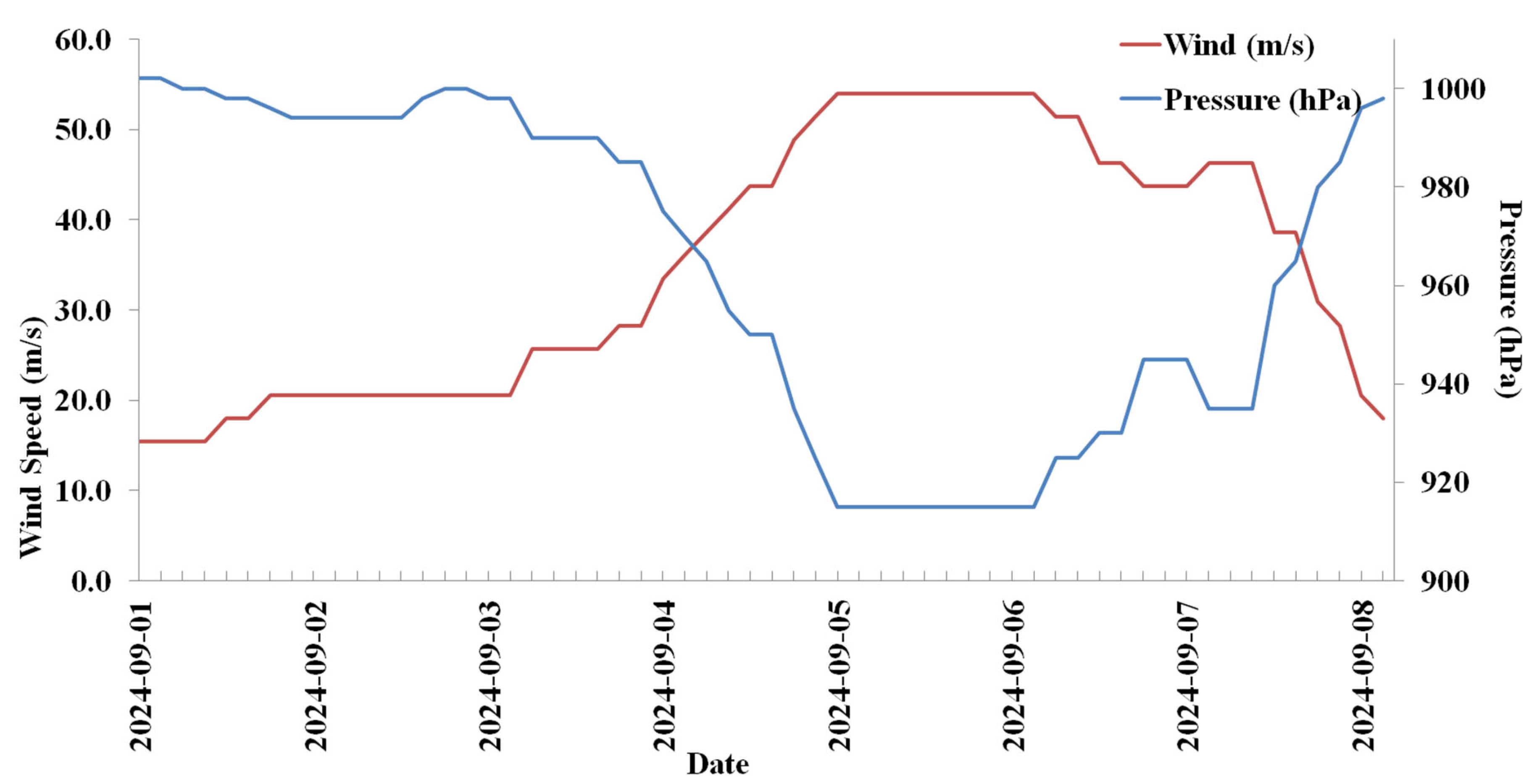
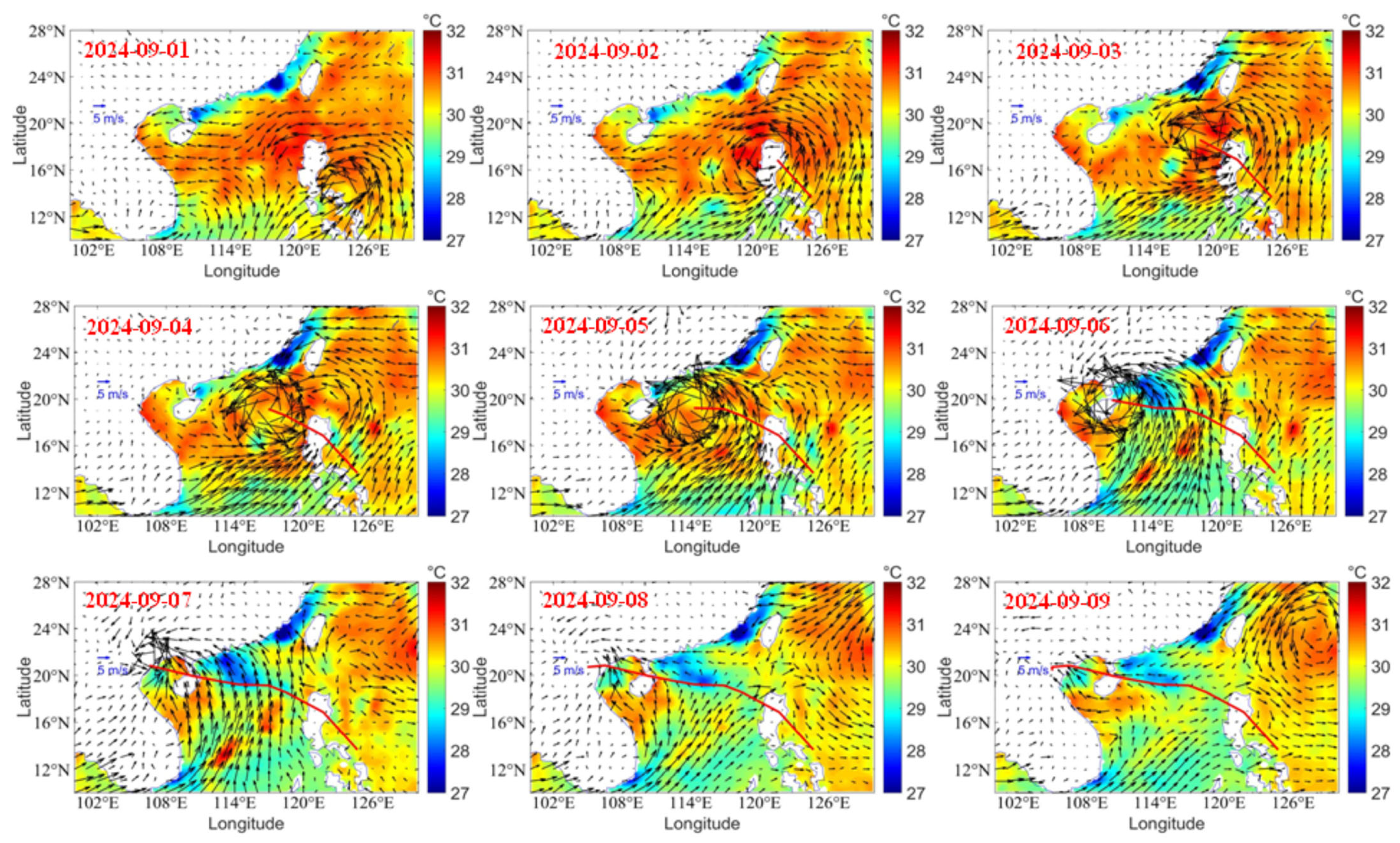
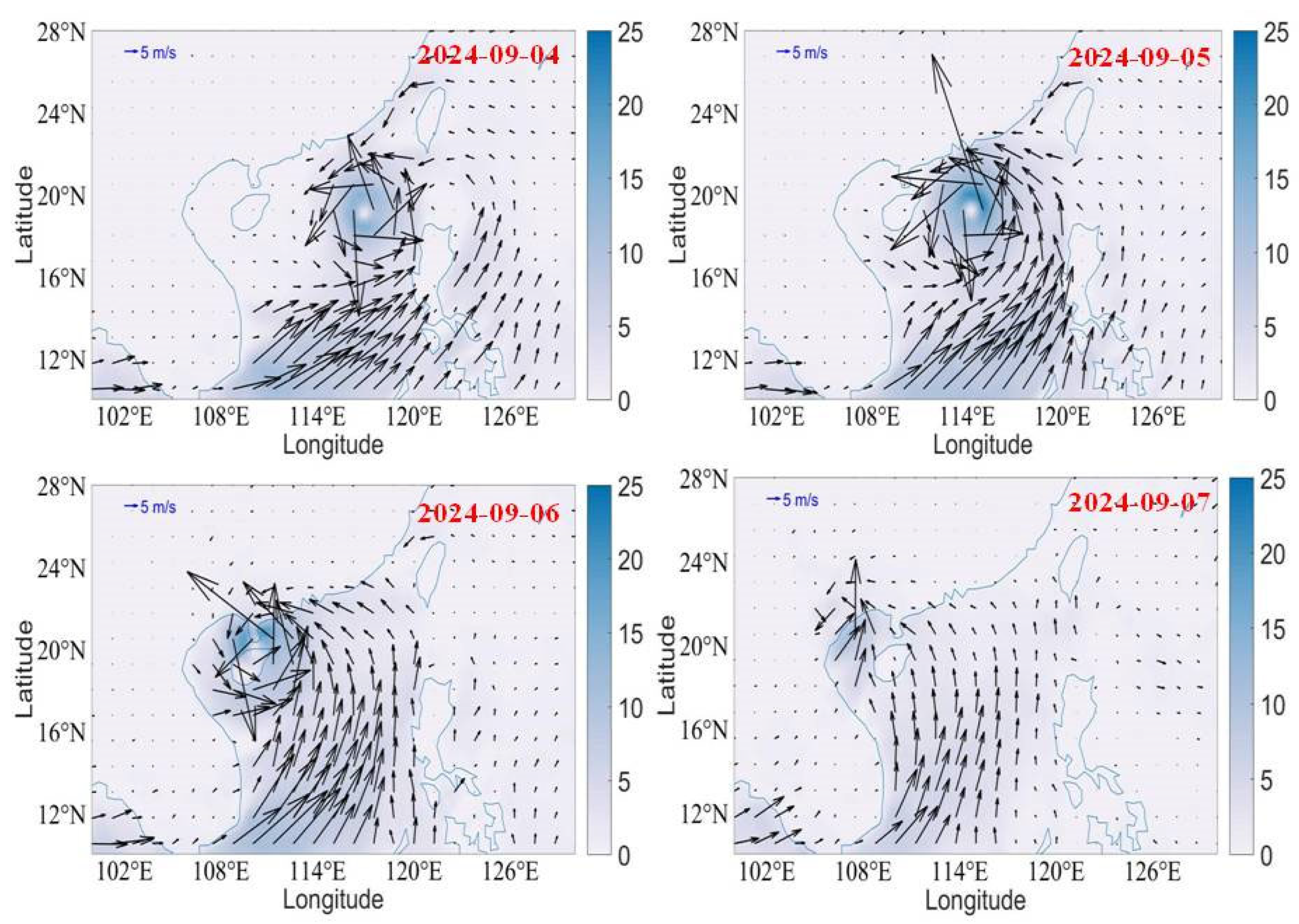



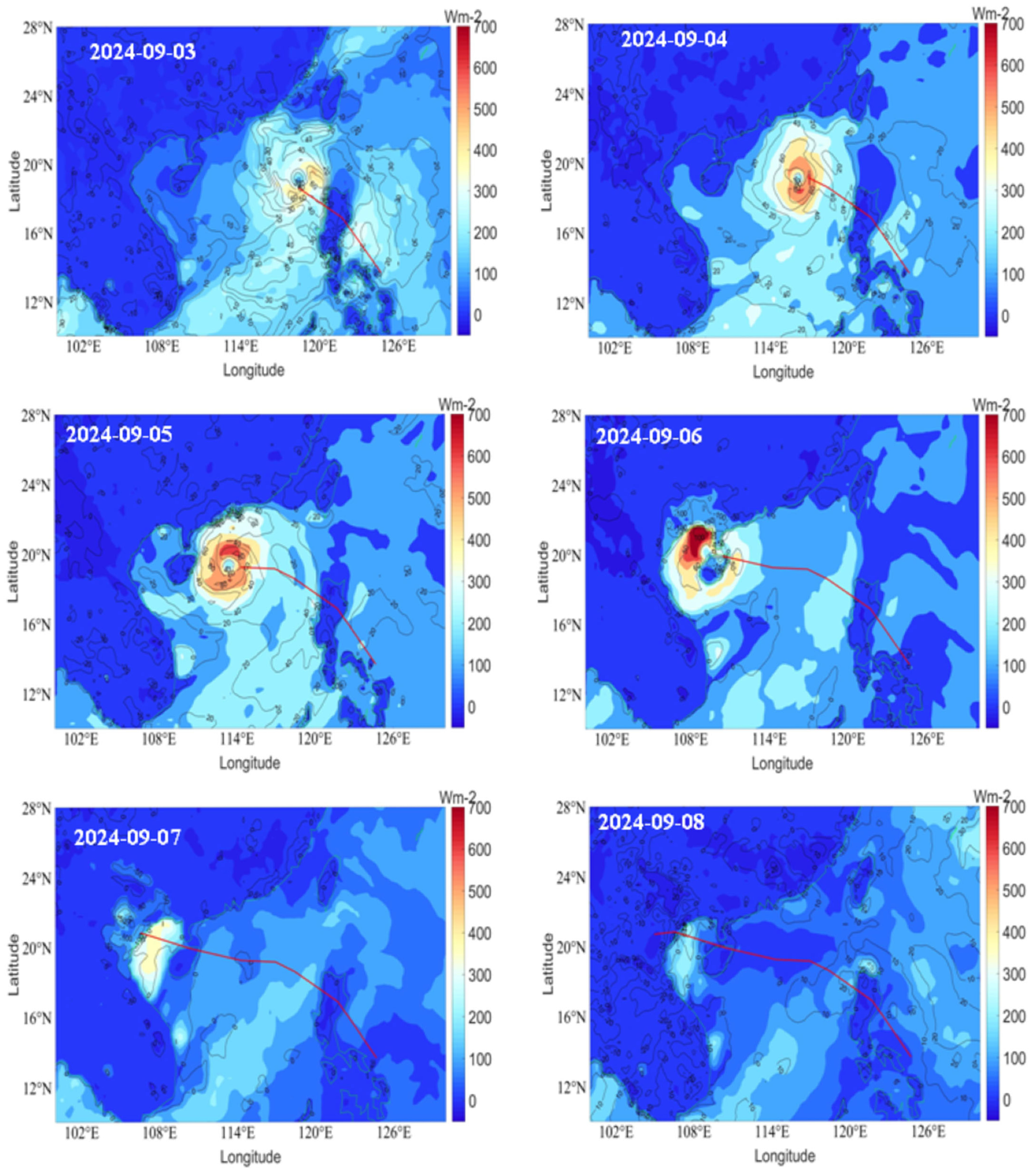
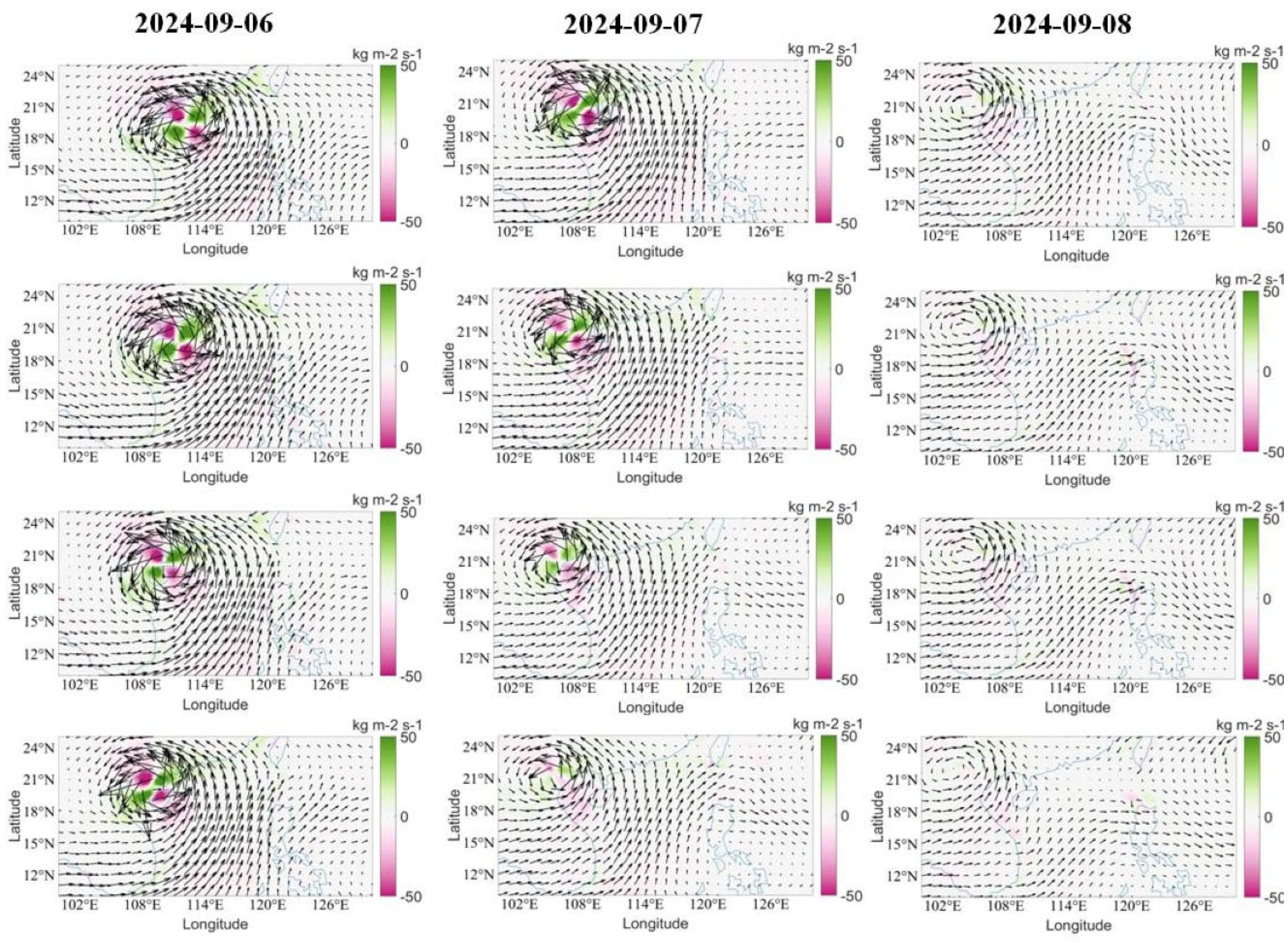
Disclaimer/Publisher’s Note: The statements, opinions and data contained in all publications are solely those of the individual author(s) and contributor(s) and not of MDPI and/or the editor(s). MDPI and/or the editor(s) disclaim responsibility for any injury to people or property resulting from any ideas, methods, instructions or products referred to in the content. |
© 2025 by the authors. Licensee MDPI, Basel, Switzerland. This article is an open access article distributed under the terms and conditions of the Creative Commons Attribution (CC BY) license (https://creativecommons.org/licenses/by/4.0/).
Share and Cite
Mantravadi, V.S.; Wang, C.; Chen, B.; Song, G. Heavy Rainfall Induced by Typhoon Yagi-2024 at Hainan and Vietnam, and Dynamical Process. Atmosphere 2025, 16, 930. https://doi.org/10.3390/atmos16080930
Mantravadi VS, Wang C, Chen B, Song G. Heavy Rainfall Induced by Typhoon Yagi-2024 at Hainan and Vietnam, and Dynamical Process. Atmosphere. 2025; 16(8):930. https://doi.org/10.3390/atmos16080930
Chicago/Turabian StyleMantravadi, Venkata Subrahmanyam, Chen Wang, Bryce Chen, and Guiting Song. 2025. "Heavy Rainfall Induced by Typhoon Yagi-2024 at Hainan and Vietnam, and Dynamical Process" Atmosphere 16, no. 8: 930. https://doi.org/10.3390/atmos16080930
APA StyleMantravadi, V. S., Wang, C., Chen, B., & Song, G. (2025). Heavy Rainfall Induced by Typhoon Yagi-2024 at Hainan and Vietnam, and Dynamical Process. Atmosphere, 16(8), 930. https://doi.org/10.3390/atmos16080930





